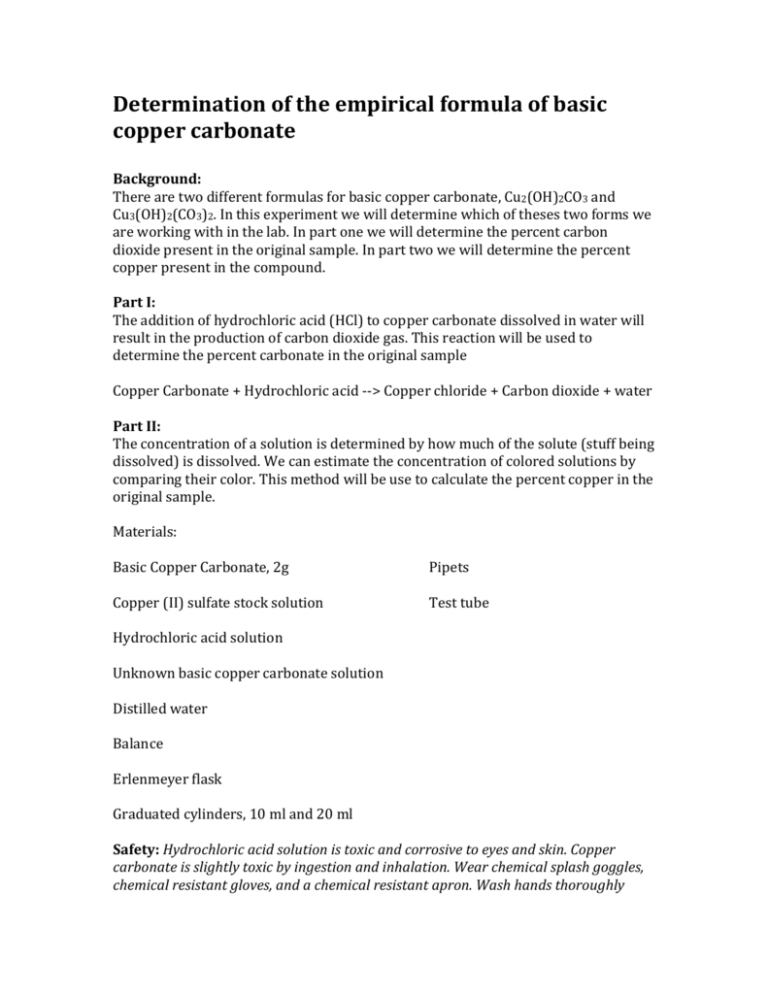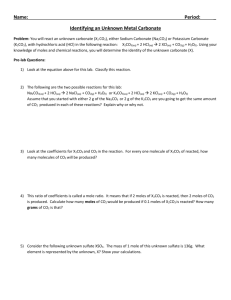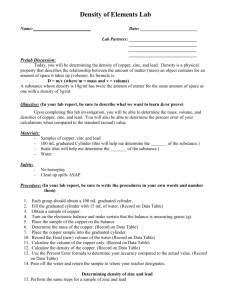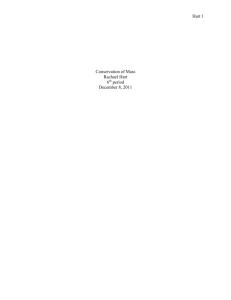Determination of the empirical formula of basic copper carbonate
advertisement

Determination of the empirical formula of basic copper carbonate Background: There are two different formulas for basic copper carbonate, Cu2(OH)2CO3 and Cu3(OH)2(CO3)2. In this experiment we will determine which of theses two forms we are working with in the lab. In part one we will determine the percent carbon dioxide present in the original sample. In part two we will determine the percent copper present in the compound. Part I: The addition of hydrochloric acid (HCl) to copper carbonate dissolved in water will result in the production of carbon dioxide gas. This reaction will be used to determine the percent carbonate in the original sample Copper Carbonate + Hydrochloric acid --> Copper chloride + Carbon dioxide + water Part II: The concentration of a solution is determined by how much of the solute (stuff being dissolved) is dissolved. We can estimate the concentration of colored solutions by comparing their color. This method will be use to calculate the percent copper in the original sample. Materials: Basic Copper Carbonate, 2g Pipets Copper (II) sulfate stock solution Test tube Hydrochloric acid solution Unknown basic copper carbonate solution Distilled water Balance Erlenmeyer flask Graduated cylinders, 10 ml and 20 ml Safety: Hydrochloric acid solution is toxic and corrosive to eyes and skin. Copper carbonate is slightly toxic by ingestion and inhalation. Wear chemical splash goggles, chemical resistant gloves, and a chemical resistant apron. Wash hands thoroughly with soap and water before leaving the laboratory. Please follow all laboratory safety guidelines. Procedure: Part I: 1.) Record the mass of one 125-mL Erlenmeyer flask and record the value in your data table, 2.) Using weighing paper measure out about 0.15 g of the basic copper carbonate sample and add it to your flask. Record the new weight of your flask in your data table. 3.) Use a 25-mL graduated cylinder to obtain 15 mL of hydrochloric acid. Measure and record the combined mass of the cylinder and acid. 4.) SLOWLY pour the hydrochloric acid into the Erlenmeyer flask. Allow the reaction of the HCl and the copper carbonate to go to completion. Measure and record the mass of the empty cylinder after adding the HCl to the flask. 5.) Once the reaction appears complete, GENTLY swirl the flask to allow any further reaction to take place. 6.) Measure and record the mass of the Erlenmeyer flask and its new contents. Part 2: 1.) Using a 10-mL graduated cylinder measure out exactly 10.0 mL of the unknown basic copper carbonate solution. 2.) Using the solutions in the test tubes provided by the teacher compare the color of the unknown solution to the color of one of the solutions in the test tubes. Once you find a color match record the amount of copper in the unknown solution in your data table. Data table: Mass of clean dry Erlenmeyer flask Mass of Erlenmeyer flask and metal carbonate sample Mass of metal carbonate Mass of graduated cylinder and HCl Mass of cylinder after HCl was added to flask Mass of HCl added to sample Mass of flask + metal carbonate + HCl Mass of flask + Final solution after loss of CO2 Mass of CO2 released Percent CO2 in metal carbonate sample Estimated mass of copper in unknown solution









